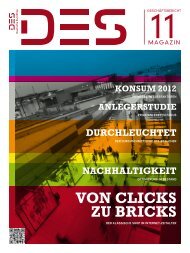Financials - Deutsche EuroShop
Financials - Deutsche EuroShop
Financials - Deutsche EuroShop
Create successful ePaper yourself
Turn your PDF publications into a flip-book with our unique Google optimized e-Paper software.
On the basis of the expert appraisals, the property portfolio has an net initial yield of 5.92% for financial year 2011, compared with 5.89% in<br />
the previous year.<br />
There is no differentiation between the domestic and international operations, as the differences are not material.<br />
Borrowing and initial rental costs that are directly attributable to the acquisition, construction or production of a qualifying asset are included<br />
in the cost of that asset until the time at which the asset is largely ready for its intended use. Income realised from the temporary investment of<br />
specifically borrowed funds up to the point when these are used to obtain qualifying assets is deducted from the capitalisable costs of these assets.<br />
All other borrowing costs are recognised in income in the period in which they occur. Maintenance measures relating to property, plant and<br />
equipment are recognised as an expense in the financial year in which they occur.<br />
No appraisal report was produced for the properties owned by CASPIA Investments Sp. z.o.o., Warsaw, due to their lesser importance. The<br />
properties were also recognised at market value in accordance with IAS 40.<br />
lEaSE aGREEMENTS<br />
In line with IAS 17, the tenancy agreements in the <strong>Deutsche</strong> <strong>EuroShop</strong> Group are classified as operating leases. The operating lease agreements<br />
relate to investment property owned by the Group with long-term leases. Rental income from operating leases is recognised in income on a<br />
straight-line basis over the term of the corresponding lease. The lessee has no opportunity to acquire the property at the end of the term.<br />
finanCial instruments<br />
ConSoLIDAteD FInAnCIAL StAteMentS financial instruments<br />
Financial assets and liabilities are recognised in the consolidated balance sheet when the Group becomes a party to the contractual provisions<br />
governing the financial instrument.<br />
Financial instruments are generally recognised at fair value. When determining fair value, three assessment categories are differentiated between:<br />
Level 1: At the first level of the “fair value hierarchy”, fair values are determined using publicly quoted market prices, as the best-possible objective<br />
indication of the fair value of a financial asset or liability can be observed on an active market.<br />
Level 2: If there is no active market for an instrument, a company determines the fair value using measurement models. These models include<br />
use of the most recent arm’s-length transactions between knowledgeable and willing parties, comparison with the current fair value of<br />
another, essentially identical financial instrument, use of the discounted cash flow method and option pricing models. The fair value is<br />
estimated on the basis of the results of a method of measurement that uses data from the market to the greatest possible extent and is<br />
based as little as possible on company-specific data.<br />
Level 3: The measurement models used for this level are based on parameters that are not observable on the market.<br />
Des Annual Report 2011 39





